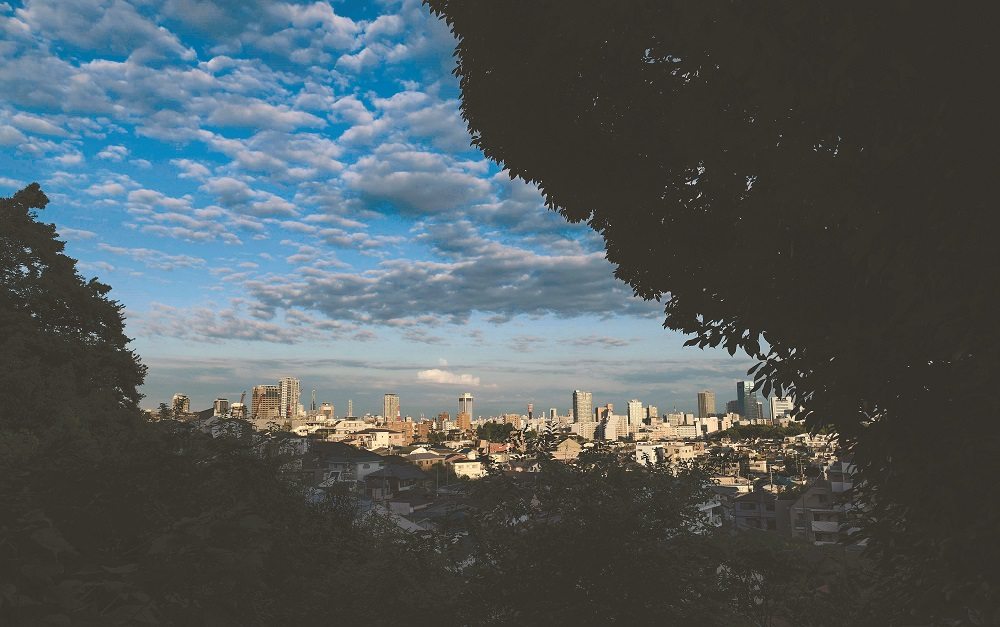
Kobe’s cityscape is seen at sunset. The sea is in the background, and Taira no Kiyomori tried to develop the seafront and surrounding area to build an international trade route.
19:28 JST, May 2, 2023
KYOTO — Kyoto is said to have been the capital of Japan from 794 to 1868. However, the capital was relocated to Fukuharakyo, an area stretching from the current Chuo Ward to the northern part of Hyogo Ward in Kobe for just six months during that long period of time, which is a fact that many Kyoto natives, including myself, do not like to talk about.
The word “capital” usually refers to a city where the central government is located, but in Japan, it originally meant the place where the Imperial Palace sat. Given this, it should be noted that people recognized Kyoto as the capital even during the Edo period (1603-1867), when the shogunate, the practical central government, was situated in Edo (now Tokyo) because the Emperor was living in Kyoto.
Taira no Kiyomori, who established the Taira clan government that is the country’s first military government between the 1160s and 1170s, relocated the capital in 1180. He took with him not only the members of the Taira clan, key figures of the regime, but also Emperor Antoku, who had just ascended the throne at a very young age. Kiyomori was the maternal grandfather of Emperor Antoku.
Kiyomori’s destination was Fukuhara, 75 kilometers west of Kyoto and located along the Seto Inland Sea. The place was at the foot of the Rokko mountain range and the Taira clan was based there by that time. From there, one could see the Owada no Tomari trading port below.
Kiyomori built a villa called Yukimi no Gosho in this place and oversaw the development and expansion of Owada no Tomari port. Not only had he amassed enormous wealth through the trade between Japan and the Song Dynasty of China, but also the Seto Inland Sea was a major shipping route linking Japan with mainland China, and waterborne transportation flourished.
“Heike Monogatari” (Tale of the Heike), which describes the rise and fall of Kiyomori’s family, states that rumors had been circulating for some time about the capital being relocated to a new location. However, people of all ranks in Kyoto were still taken aback and fell into an uproar when they discovered that it would happen so soon. This part of the story suggests that the relocation of the capital was unexpected for many people.
At the beginning of the capital’s relocation, there was no dairi, which was the Emperor’s residence. Instead, the residences of the Taira clan were used as places for the Emperor and joko, or Emperor Emeritus, to stay. A few months later, Kiyomori finally began the construction of the dairi and the residences of other nobles also began to be built.
Despite the relocation of the capital, many aristocrats remained in Kyoto and opposed the move. The capital returned to Kyoto after only six months, without having fully functioned as a capital. One reason behind the move was that the rebellions against the Taira government were taking place in various parts of Japan, including the raising of an army by Minamoto no Yoritomo in Kamakura in the eastern part of Japan.
What on earth were the aims of the relocation?
Masaaki Takahashi, a professor emeritus at Kobe University, suggests that “the aim was to create a capital suitable for a new dynasty.” However, this new dynasty did not entail Kiyomori’s own ascension to the throne. During the Heian period, Japan had a political system in which the Emperor’s father or grandfather held the actual supreme authority. Until the middle of the Heian period, this position was occupied by the head of the Fujiwara Hokke family, who functioned as the Emperor’s maternal grandfather. Later, the position of real power was held by one of several joko.
Kiyomori was the maternal grandfather of Emperor Antoku and is believed to have envisioned a “new dynasty of the Taira line” in which the chief of the Taira clan would continue to hold power as the maternal grandfather of the successor Emperor. Kiyomori is thought to have intended to give the impression of a new reign by relocating the capital from Kyoto to Fukuhara. If the capital had remained in Fukuhara, Japan may have shifted its main industry from agriculture to commerce at an earlier point.
"JN Specialities" POPULAR ARTICLE
-

The Japan News / Weekly Edition (12/12-12/18)
-

Noodle Dining Shunsai / Rich Oyster Ramen to Savor at Odasaga; Experienced 68-year-old Owner Creates Numerous Ramen Varieties
-

The Japan News / Weekly Edition (12/5-12/11)
-

People Keep Loved Ones’ Ashes Close in Special Jewelry, Small Urns as Unique Way to Memorialize Them
-

The Japan News / Weekly Edition (12/19-12/25)
JN ACCESS RANKING
-

Tokyo Economic Security Forum to Hold Inaugural Meeting Amid Tense Global Environment
-

Keidanren Chairman Yoshinobu Tsutsui Visits Kashiwazaki-Kariwa Nuclear Power Plant; Inspects New Emergency Safety System
-

Imports of Rare Earths from China Facing Delays, May Be Caused by Deterioration of Japan-China Relations
-

University of Tokyo Professor Discusses Japanese Economic Security in Interview Ahead of Forum
-

Japan Pulls out of Vietnam Nuclear Project, Complicating Hanoi’s Power Plans

























